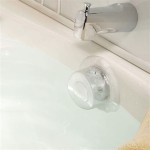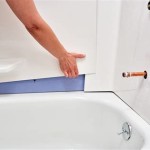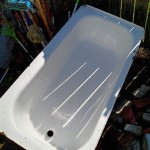How to Sand and Paint a Bathtub
Refinishing a bathtub can be a cost-effective way to update a bathroom without a complete renovation. Sanding and painting a bathtub can transform its look and feel, restoring its shine and eliminating unsightly blemishes. This process requires careful preparation, meticulous execution, and the right materials. This article provides a comprehensive guide to sanding and painting a bathtub, encompassing essential steps and considerations.
Preparing for the Sanding and Painting Process
Before diving into the sanding and painting, it’s crucial to prepare the bathtub. This preparation step involves thoroughly cleaning the bathtub and masking surrounding areas to prevent paint splatters. The steps include:
- Empty and Clean the Bathtub: Remove all items from the bathtub, such as soap dishes, showerheads, and any other fixtures. Thoroughly clean the bathtub with a heavy-duty cleaner to remove dirt, grime, and soap residue. Pay special attention to areas with mold or mildew, using a mildew-removing solution if necessary. Rinse the bathtub thoroughly with clean water and allow it to dry completely.
- Mask Surrounding Areas: Cover surrounding surfaces, including walls, floors, and fixtures, with painter’s tape and drop cloths to prevent paint splatters and spills. Ensure the masking tape adheres well to the surfaces to prevent paint from seeping underneath.
- Prepare the Bathtub Surface: If the bathtub has any loose or peeling paint, use a scraper to remove it. Additionally, use sandpaper to smooth out any rough or uneven areas.
Proper preparation is crucial for a successful sanding and painting project. It ensures a clean and smooth surface, allowing the paint to adhere properly and provide a durable finish.
Sanding the Bathtub
Sanding the bathtub surface is essential to create a smooth and textured surface for the paint to adhere to. It removes any imperfections, such as scratches, chips, or uneven surfaces, creating a uniform base for the paint. The sanding process involves using sandpaper with varying grits to achieve the desired smoothness. The steps include:
- Start with Coarse Grit Sandpaper: Begin with a coarse grit sandpaper, such as 80-grit, to remove any significant imperfections or rough areas. Use a sanding block or a piece of wood for support, applying even pressure as you sand the bathtub surface in a back and forth motion. Ensure you sand in the direction of the bathtub's grain, if visible, for a consistent finish.
- Progress to Finer Grit Sandpaper: After using the coarse grit sandpaper, move to a finer grit sandpaper, such as 120-grit, and repeat the sanding process. This step further smooths the surface and removes any remaining imperfections. Continue using progressively finer grit sandpaper, such as 220-grit and 400-grit, to achieve a smooth and polished surface.
- Sand the Edges and Corners: Pay special attention to the edges and corners of the bathtub, using a small sanding block or sandpaper wrapped around a finger to reach these areas thoroughly. Sand these areas with the same grit sandpaper used for the main surface, ensuring a smooth and consistent finish throughout.
Sanding the bathtub thoroughly is crucial for a successful paint job. It creates a smooth surface that allows the paint to adhere properly and produce a durable finish.
Painting the Bathtub
Once the sanding is complete, the bathtub is ready for painting. This step involves applying primer and enamel paint to the bathtub surface, creating a durable and aesthetically pleasing finish. The painting process involves several steps, including:
- Apply Primer: Begin by applying a primer specifically designed for bathtubs and other wet surfaces. Choose a primer that is oil-based or epoxy-based for maximum durability. Apply a thin, even coat of primer using a brush or roller, ensuring complete coverage of the bathtub surface. Allow the primer to dry completely according to the manufacturer’s instructions before proceeding to the next step.
- Apply Enamel Paint: Once the primer is dry, apply two coats of enamel paint designed for bathtubs. Choose a color that complements the bathroom décor and provides the desired aesthetic. Apply the paint using a brush or roller, ensuring even coverage and avoiding drips or runs. Allow each coat to dry completely according to the manufacturer’s instructions before applying the next coat.
- Finish with a Clear Coat: After the final coat of enamel paint is dry, apply a clear coat for added protection and durability. This step helps protect the paint from scratches and wear and tear, ensuring a longer-lasting finish. Choose a clear coat specifically designed for bathtubs and apply it according to the manufacturer’s instructions.
Painting the bathtub requires careful preparation and execution. The right primer and enamel paint, along with proper application techniques, ensure a durable and aesthetically pleasing finish.

Super Simple How To Paint A Bathtub

Before After How To Paint A Bathtub And Clean It Does Last Thrift Diving

How To Paint A Bathtub Yourself The Nifty Nester

How To Paint A Tub With Rustoleum What Not Do

Diy Painted Bathtub Follow Up Your Questions Answered Addicted 2 Decorating

How To Paint A Bathtub Rustoleum Tub And Tile House Becoming Home

Yes You Can Paint Your Bathtub And Tile Here S How Toolbox Divas

How To Paint A Bathtub Ace Hardware

How To Paint A Bathtub Rustoleum Tub And Tile House Becoming Home

How To Refinish An Old Clawfoot Bath Tub








